Atopic Dermatitis in Children Under 5: Prevalence Trends in Central, Eastern, and Western Europe
Abstract
1. Introduction
2. Methods
2.1. Study Design
2.2. Study Population
2.3. Data Source
2.4. Measures
2.5. Statistical Analysis
2.6. Ethics Statement
3. Results
4. Discussion
Limitations of the Study
5. Conclusions
Author Contributions
Funding
Institutional Review Board Statement
Informed Consent Statement
Data Availability Statement
Acknowledgments
Conflicts of Interest
References
- Hadi, H.A.; Tarmizi, A.I.; Khalid, K.A.; Gajdács, M.; Aslam, A.; Jamshed, S. The Epidemiology and Global Burden of Atopic Dermatitis: A Narrative Review. Life 2021, 11, 936. [Google Scholar] [CrossRef] [PubMed]
- Bylund, S.; Kobyletzki, L.B.; Svalstedt, M.; Svensson, Å. Prevalence and Incidence of Atopic Dermatitis: A Systematic Review. Acta Derm. Venereol. 2020, 100, adv00160. [Google Scholar] [CrossRef] [PubMed]
- Laughter, M.R.; Maymone, M.B.C.; Mashayekhi, S.; Arents, B.W.M.; Karimkhani, C.; Langan, S.M.; Dellavalle, R.P.; Flohr, C. The global burden of atopic dermatitis: Lessons from the Global Burden of Disease Study 1990-2017. Br. J. Dermatol. 2021, 184, 304–309. [Google Scholar] [CrossRef] [PubMed]
- Chester, J.; Kaleci, S.; Liberati, S.; Alicandro, T.; Rivi, M.; Bonzano, L.; Guanti, M.; Andreone, P.; Pellacani, G. Atopic dermatitis associated with autoimmune, cardiovascular and mental health comorbidities: A systematic review and meta-analysis. Eur. J. Dermatol. 2022, 32, 34–48. [Google Scholar]
- Nutten, S. Atopic dermatitis: Global epidemiology and risk factors. Ann. Nutr. Metab. 2015, 66 (Suppl. S1), 8–16. [Google Scholar] [CrossRef]
- Raimondo, A.; Lembo, S. Atopic Dermatitis: Epidemiology and Clinical Phenotypes. Dermatol. Pract. Concept. 2021, 11, e2021146. [Google Scholar] [CrossRef]
- Kapur, S.; Watson, W.; Carr, S. Atopic dermatitis. Allergy Asthma Clin. Immunol. 2018, 14, 52. [Google Scholar] [CrossRef]
- GBD 2019 Diseases and Injuries Collaborators. Global burden of 369 diseases and injuries in 204 countries and territories, 1990–2019: A systematic analysis for the Global Burden of Disease Study 2019. Lancet 2020, 396, 1204–1222. [Google Scholar] [CrossRef]
- Pugliarello, S.; Cozzi, A.; Gisondi, P.; Girolomoni, G. Phenotypes of atopic dermatitis. J. Dtsch. Dermatol. Ges. 2011, 9, 12–20. [Google Scholar] [CrossRef]
- Paller, A.S.; Simpson, E.L.; Siegfried, E.C.; Cork, M.J.; Wollenberg, A.; Arkwright, P.D.; Soong, W.; Gonzalez, M.E.; Schneider, L.C.; Sidbury, R.; et al. participating investigators. Dupilumab in children aged 6 months to 6 years with uncontrolled atopic dermatitis: A phase 3, randomized, double-blind, placebo-controlled study. Lancet 2022, 400, 908–919. [Google Scholar] [CrossRef]
- Blauvelt, A.; Teixeira, H.D.; Simpson, E.L.; Costanzo, A.; De Bruin-Weller, M.; Barbarot, S.; Prajapati, V.H.; Lio, P.; Hu, X.; Wu, T.; et al. Efficacy and Safety of Upadacitinib vs Dupilumab in Adults With Moderate-to-Severe Atopic Dermatitis: A Randomized Clinical Trial. JAMA Dermatol. 2021, 157, 1047–1055. [Google Scholar] [CrossRef]
- Stevens, G.A.; Alkema, L.; Black, R.E.; Boerma, J.T.; Collins, G.S.; Ezzati, M.; Grove, J.T.; Hogan, D.R.; Hogan, M.C.; Horton, R.; et al. Guidelines for Accurate and Transparent Health Estimates Reporting: The GATHER statement. Lancet 2016, 388, e19–e23. [Google Scholar] [CrossRef]
- United Nations Development Programme. Human Development Index (HDI). Available online: https://hdr.undp.org/ (accessed on 5 June 2023).
- Kim, H.J.; Fay, M.P.; Feuer, E.J.; Midthune, D.N. Permutation tests for joinpoint regression with applications to cancer rates. Stat. Med. 2000, 19, 335–351. [Google Scholar] [CrossRef]
- Lerman, P.M. Fitting segmented regression models by grid search. Appl. Stat. 1980, 29, 77–84. [Google Scholar] [CrossRef]
- Clegg, L.X.; Hankey, B.F.; Tiwari, R.; Feuer, E.J.; Edwards, B.K. Estimating average annual per cent change in trend analysis. Stat. Med. 2009, 28, 3670–3682. [Google Scholar] [CrossRef]
- Kowalska-Olędzka, E.; Czarnecka, M.; Baran, A. Epidemiology of atopic dermatitis in Europe. J. Drug Assess. 2019, 8, 126–128. [Google Scholar] [CrossRef]
- Volke, A.; Toompere, K.; Laisaar, K.T.; Oona, M.; Tisler, A.; Johannson, A.; Kallavus, K.; Lang, K.; Kiisk, E.; Uusküla, A. 12-month prevalence of atopic dermatitis in resource-rich countries: A systematic review and meta-analysis. Sci. Rep. 2022, 12, 15125. [Google Scholar] [CrossRef]
- Urban, K.; Chu, S.; Giesey, R.L.; Mehrmal, S.; Uppal, P.; Nedley, N.; Delost, G.R. The global, regional, and national burden of atopic dermatitis in 195 countries and territories: An ecological study from the Global Burden of Disease Study 2017. JAAD Int. 2020, 2, 12–18. [Google Scholar] [CrossRef] [PubMed]
- Langan, S.M.; Irvine, A.D.; Weidinger, S. Atopic dermatitis. Lancet 2020, 396, 345–360. [Google Scholar] [CrossRef]
- Napolitano, M.; Fabbrocini, G.; Martora, F.; Genco, L.; Noto, M.; Patruno, C. Children atopic dermatitis: Diagnosis, mimics, overlaps, and therapeutic implication. Dermatol. Ther. 2022, 35, e15901. [Google Scholar] [CrossRef]
- Williams, H.C.; Burney, P.G.; Pembroke, A.C.; Hay, R.J. Validation of the U.K. diagnostic criteria for atopic dermatitis in a population setting. U.K. Diagnostic Criteria for Atopic Dermatitis Working Party. Br. J. Dermatol. 1996, 135, 12–17. [Google Scholar] [CrossRef]
- Stefanovic, N.; Irvine, A.D.; Flohr, C. The Role of the Environment and Exposome in Atopic Dermatitis. Curr. Treat. Options Allergy 2021, 8, 222–241. [Google Scholar] [CrossRef] [PubMed]
- Flohr, C.; Quinnell, R.J.; Britton, J. Do helminth parasites protect against atopy and allergic disease? Clin. Exp. Allergy 2009, 39, 20–32. [Google Scholar] [CrossRef] [PubMed]
- Singh, S.; Sharma, B.B.; Salvi, S.; Chhatwal, J.; Jain, K.C.; Kumar, L.; Joshi, M.K.; Pandramajal, S.B.; Awasthi, S.; Bhave, S.; et al. Allergic rhinitis, rhinoconjunctivitis, and eczema: Prevalence and associated factors in children. Clin. Respir. J. 2018, 12, 547–556. [Google Scholar] [CrossRef] [PubMed]
- Mosam, A.; Todd, G. Global epidemiology and disparities in atopic dermatitis. Br. J. Dermatol. 2023, 188, 726–737. [Google Scholar] [CrossRef]
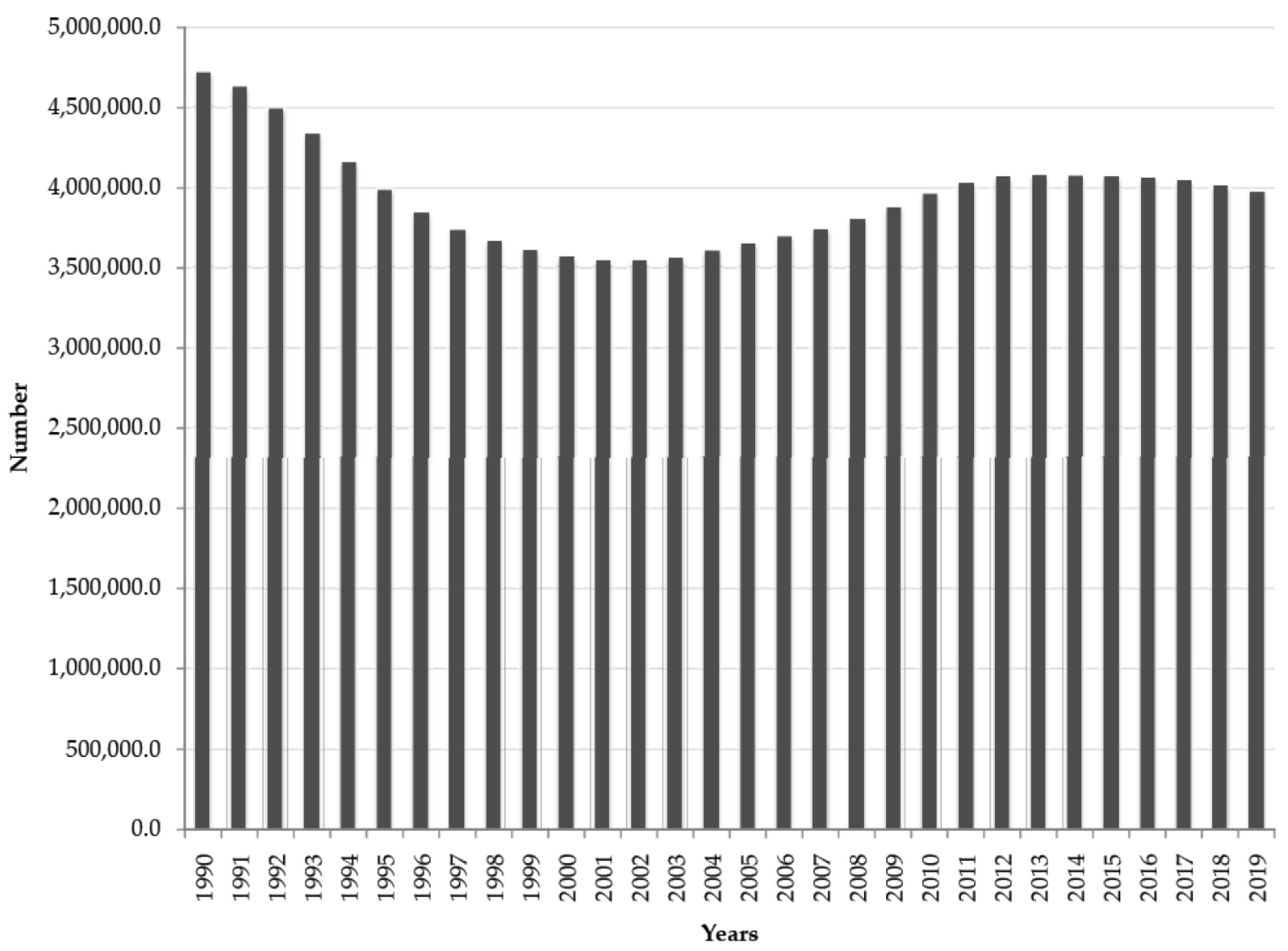
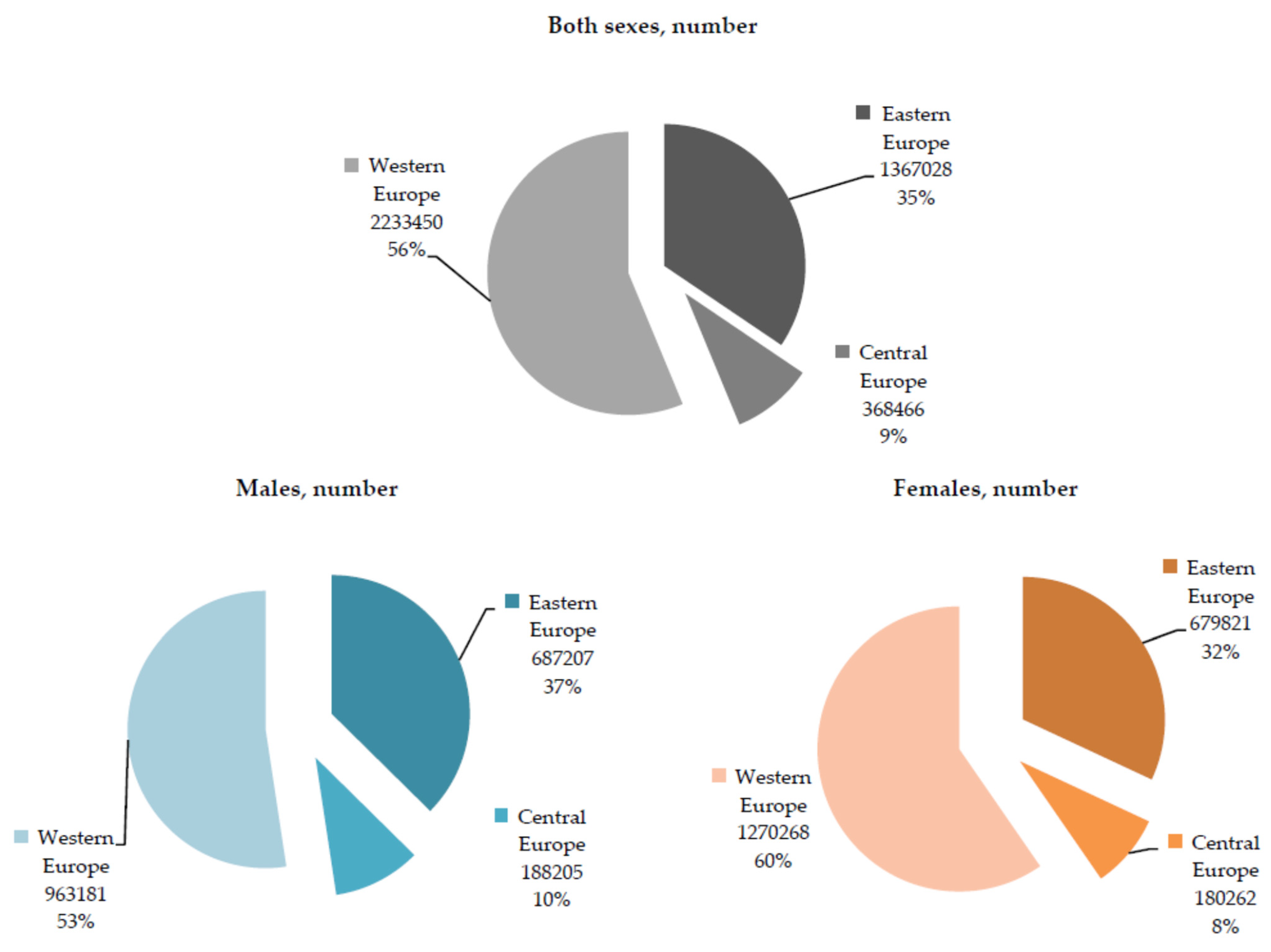
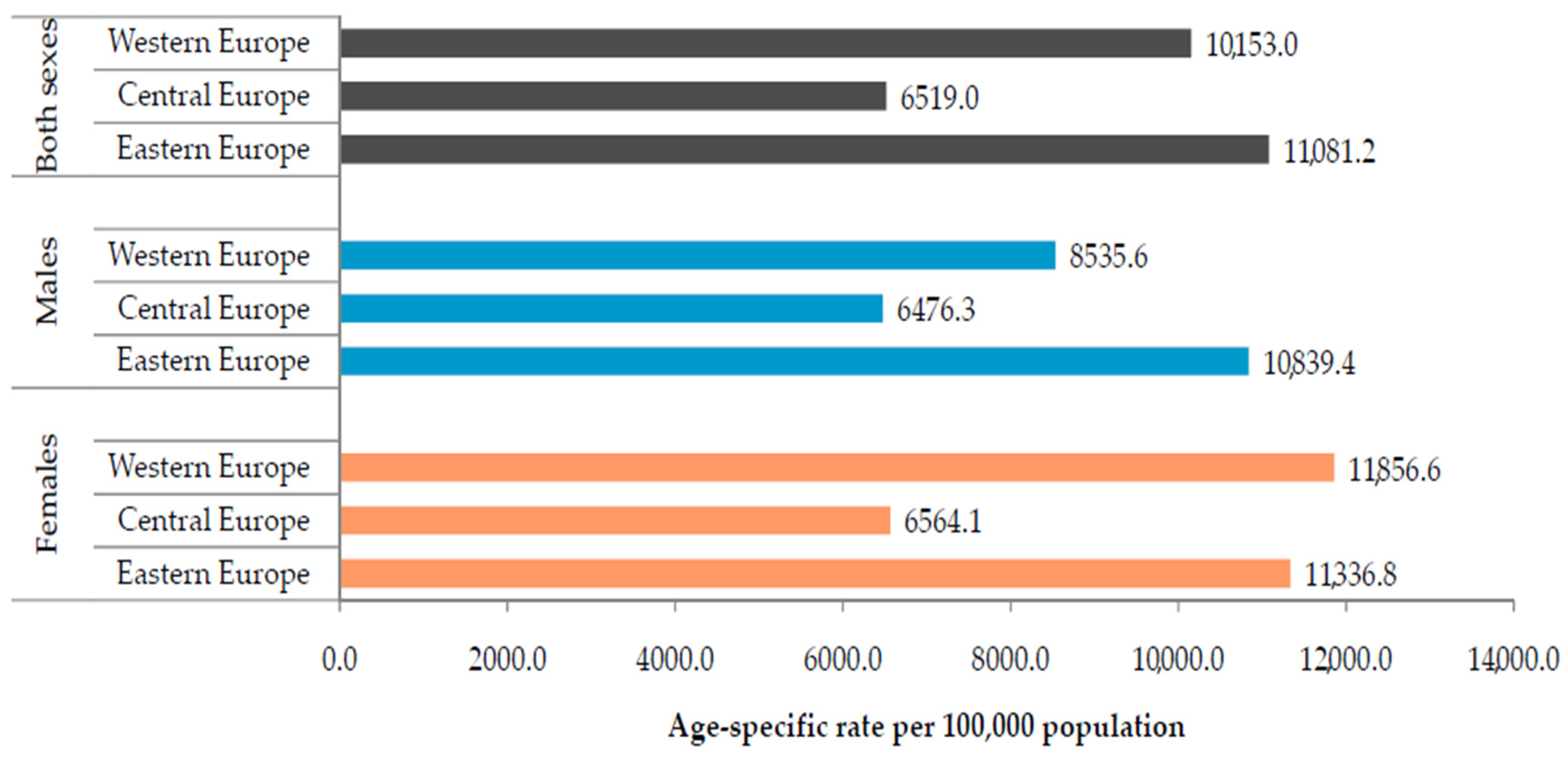
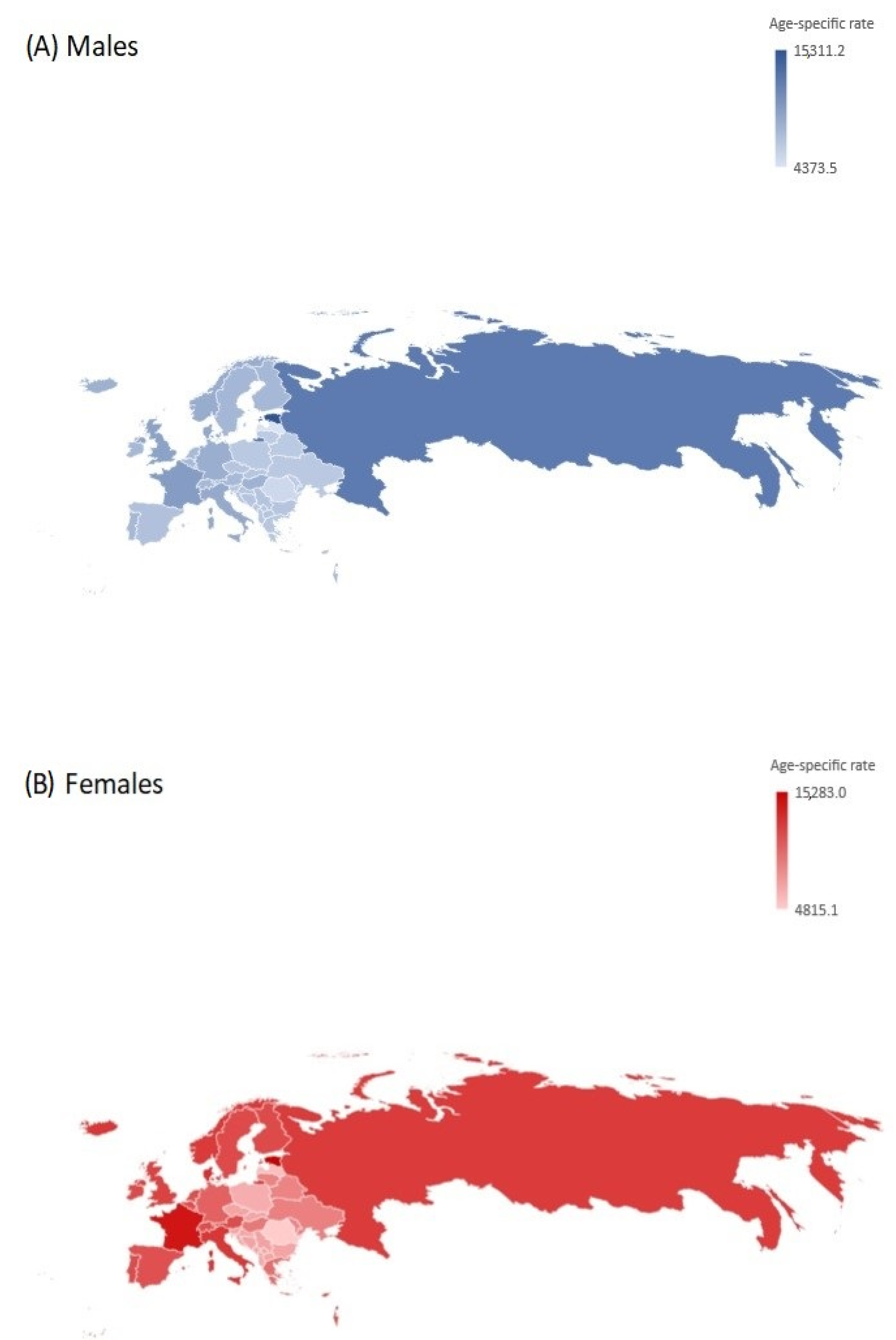
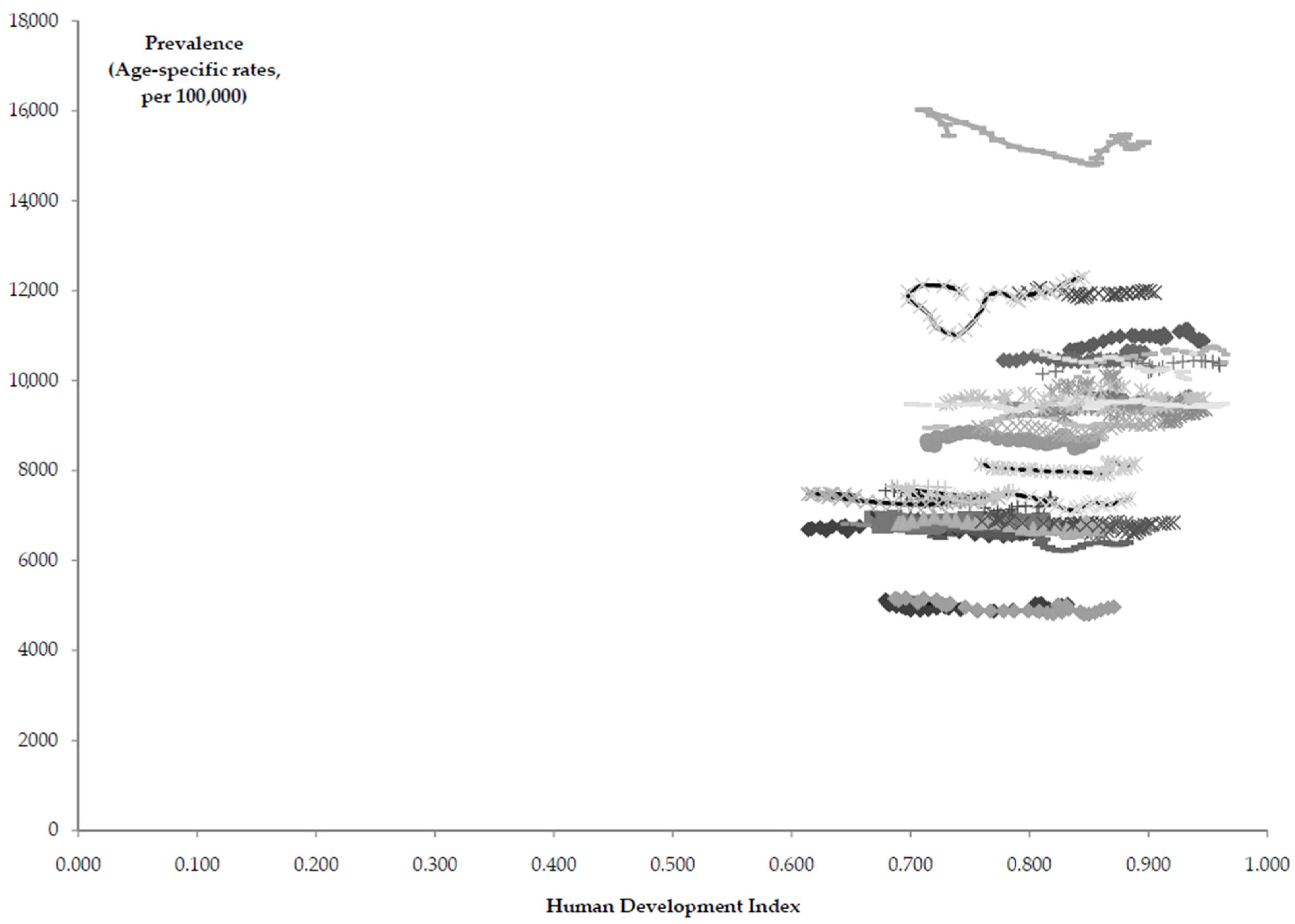
| Locations ** | Males | Females | Both Sexes—HDI | |||||
|---|---|---|---|---|---|---|---|---|
| 1990 | 2019 | AAPC | 1990 | 2019 | AAPC | Pearson Coefficient | p | |
| Western Europe | 8497.4 | 8535.6 | −0.1 * | 11,768.9 | 11,856.6 | 0.0 | - | - |
| Central Europe | 6473.9 | 6476.3 | −0.1 * | 6577.8 | 6564.1 | −0.1 * | - | - |
| Eastern Europe | 10,116.0 | 10,839.4 | 0.3 * | 10,980.6 | 11,336.8 | 0.1 * | - | - |
| Albania | 6576.5 | 6538.6 | −0.1 * | 6739.6 | 6733.7 | −0.1 * | −0.628 | 0.000 |
| Andorra | 7742.6 | 7893.9 | +0.2 * | 11,556.9 | 11,754.3 | 0.1 * | 0.632 | 0.003 |
| Austria | 7599.5 | 7635.3 | −0.0 | 11,324.5 | 11,374.6 | −0.0 | −0.239 | 0.204 |
| Belarus | 6379.7 | 6325.7 | −0.2 * | 8626.4 | 8544.4 | −0.1 * | −0.621 | 0.001 |
| Belgium | 7569.6 | 7653.5 | 0.0 | 11,276.0 | 11,404.4 | 0.0 | 0.234 | 0.214 |
| Bosnia and Herzegovina | 6743.5 | 6784.3 | −0.0 | 6947.2 | 6991.7 | −0.0 | −0.354 | 0.126 |
| Bulgaria | 6754.8 | 6719.0 | −0.1 * | 6963.7 | 6923.0 | −0.1 * | −0.514 | 0.004 |
| Croatia | 6759.0 | 6716.7 | −0.0 | 6967.5 | 6923.4 | −0.0 | −0.375 | 0.041 |
| Cyprus | 7029.1 | 7093.0 | −0.0 | 10,997.1 | 11,099.0 | −0.0 | −0.251 | 0.181 |
| Czechia | 6683.9 | 6695.6 | −0.1 * | 6889.0 | 6900.6 | −0.1 * | −0.493 | 0.006 |
| Denmark | 8832.4 | 9002.7 | 0.0 * | 12,626.1 | 12,872.1 | 0.1 * | 0.700 | 0.000 |
| Estonia | 15,448.3 | 15,311.2 | −0.1 * | 15,439.4 | 15,283.0 | −0.2 * | −0.698 | 0.000 |
| Finland | 7555.6 | 7717.7 | 0.0 * | 11,253.7 | 11,496.8 | 0.0* | 0.418 | 0.021 |
| France | 9806.7 | 9815.9 | −0.0 | 14,168.4 | 14,181.7 | 0.0 | −0.093 | 0.626 |
| Germany | 8354.4 | 8480.5 | −0.0 | 10,164.3 | 10,298.4 | −0.0 | −0.344 | 0.063 |
| Greece | 6666.3 | 6655.0 | 0.0 | 9682.7 | 9711.0 | 0.0 | 0.042 | 0.825 |
| Hungary | 8092.0 | 8180.7 | −0.0 * | 9052.4 | 9149.5 | −0.1 * | −0.408 | 0.025 |
| Iceland | 8139.4 | 8258.9 | −0.0 | 12,246.9 | 12,466.6 | 0.0 | 0.003 | 0.989 |
| Ireland | 7764.1 | 7709.1 | −0.0 | 11,580.6 | 11,486.1 | −0.0 | −0.289 | 0.122 |
| Israel | 7647.0 | 7587.7 | 0.0 * | 11,399.5 | 11,306.8 | −0.0 * | −0.591 | 0.001 |
| Italy | 8688.0 | 8832.1 | 0.1 * | 12,313.2 | 12,512.9 | 0.1 * | 0.520 | 0.003 |
| Latvia | 4394.2 | 4373.5 | −0.2 * | 5628.8 | 5591.7 | −0.2 * | −0.770 | 0.000 |
| Lithuania | 6258.4 | 6289.8 | −0.1 * | 8459.2 | 8498.9 | −0.1 * | −0.734 | 0.000 |
| Luxembourg | 7516.4 | 7629.2 | 0.1 * | 11,189.9 | 11,371.8 | 0.1 * | 0.771 | 0.000 |
| Malta | 7653.3 | 7658.8 | −0.1 * | 11,402.1 | 11,386.8 | −0.1 * | −0.703 | 0.000 |
| Monaco | 7376.2 | 7700.2 | 0.1 * | 10,865.2 | 11,416.9 | 0.1 * | - | - |
| Montenegro | 6749.3 | 6710.5 | −0.0 * | 6962.1 | 6909.9 | −0.0 * | −0.033 | 0.901 |
| Netherlands | 7554.7 | 7610.9 | 0.0 * | 11,258.8 | 11,340.1 | 0.0 * | 0.471 | 0.009 |
| North Macedonia | 6683.7 | 6694.9 | −0.0 * | 6898.9 | 6900.5 | −0.1 * | −0.598 | 0.002 |
| Norway | 8344.0 | 8611.8 | 0.1 * | 11,897.5 | 12,283.7 | 0.1 * | 0.760 | 0.000 |
| Poland | 6625.3 | 6409.3 | −0.2 * | 6708.1 | 6391.5 | −0.3 * | −0.790 | 0.000 |
| Portugal | 7650.2 | 7679.5 | 0.0 * | 11,395.7 | 11,442.0 | 0.0 * | 0.409 | 0.025 |
| Republic of Moldova | 6335.1 | 6310.9 | −0.1 * | 8568.6 | 8527.0 | −0.1 * | −0.561 | 0.001 |
| Romania | 5243.9 | 5213.8 | −0.0 | 4814.7 | 4815.1 | −0.0 | −0.180 | 0.342 |
| Russian Federation | 11,819.1 | 12,350.6 | 0.2 * | 12,038.0 | 12,248.7 | 0.1 | 0.542 | 0.002 |
| San Marino | 7683.1 | 7683.2 | 0.0 * | 11,486.2 | 11,458.9 | 0.0 * | - | - |
| Serbia | 6564.6 | 6800.7 | 0.1 * | 6936.2 | 6997.2 | 0.0 | 0.453 | 0.012 |
| Slovakia | 6720.9 | 6678.0 | −0.1 * | 6928.8 | 6881.7 | −0.1 * | −0.684 | 0.000 |
| Slovenia | 6794.2 | 6746.0 | −0.1 * | 7007.8 | 6949.5 | −0.1 * | −0.610 | 0.000 |
| Spain | 6963.1 | 7016.6 | 0.1 * | 11,096.4 | 11,173.8 | 0.0 | 0.260 | 0.165 |
| Sweden | 7565.0 | 7751.3 | −0.0 | 11,263.6 | 11,539.0 | −0.0 | −0.055 | 0.772 |
| Switzerland | 7575.9 | 7657.9 | −0.0 | 11,291.6 | 11,407.3 | −0.0 | −0.350 | 0.058 |
| Ukraine | 6490.5 | 6446.3 | −0.1 * | 8807.1 | 8734.6 | −0.1 * | 0.571 | 0.001 |
| United Kingdom | 9417.4 | 9336.6 | −0.1 * | 11,965.9 | 11,921.7 | −0.1 * | −0.788 | 0.000 |
Disclaimer/Publisher’s Note: The statements, opinions and data contained in all publications are solely those of the individual author(s) and contributor(s) and not of MDPI and/or the editor(s). MDPI and/or the editor(s) disclaim responsibility for any injury to people or property resulting from any ideas, methods, instructions or products referred to in the content. |
© 2023 by the authors. Licensee MDPI, Basel, Switzerland. This article is an open access article distributed under the terms and conditions of the Creative Commons Attribution (CC BY) license (https://creativecommons.org/licenses/by/4.0/).
Share and Cite
Ilic, I.; Stojkovic, A.; Velickovic, V.; Zivanovic Macuzic, I.; Ilic, M. Atopic Dermatitis in Children Under 5: Prevalence Trends in Central, Eastern, and Western Europe. Children 2023, 10, 1275. https://doi.org/10.3390/children10081275
Ilic I, Stojkovic A, Velickovic V, Zivanovic Macuzic I, Ilic M. Atopic Dermatitis in Children Under 5: Prevalence Trends in Central, Eastern, and Western Europe. Children. 2023; 10(8):1275. https://doi.org/10.3390/children10081275
Chicago/Turabian StyleIlic, Irena, Andjelka Stojkovic, Vesna Velickovic, Ivana Zivanovic Macuzic, and Milena Ilic. 2023. "Atopic Dermatitis in Children Under 5: Prevalence Trends in Central, Eastern, and Western Europe" Children 10, no. 8: 1275. https://doi.org/10.3390/children10081275
APA StyleIlic, I., Stojkovic, A., Velickovic, V., Zivanovic Macuzic, I., & Ilic, M. (2023). Atopic Dermatitis in Children Under 5: Prevalence Trends in Central, Eastern, and Western Europe. Children, 10(8), 1275. https://doi.org/10.3390/children10081275





